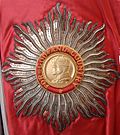Percy Noble (Royal Navy officer) facts for kids
Quick facts for kids
Sir Percy Noble
|
|
|---|---|

Sir Percy Noble in 1946, by Oswald Birley
|
|
| Birth name | Percy Lockhart Harnam Noble |
| Born | 16 January 1880 Bengal, India |
| Died | 25 July 1955 (aged 75) London, UK |
| Allegiance | |
| Service/ |
|
| Years of service | 1894–1945 |
| Rank | Admiral |
| Commands held |
|
| Battles/wars | |
| Awards | |
| Relations | Colonel Charles Noble (father); Sir Allan Noble MP (son) |
Sir Percy Lockhart Harnam Noble (born January 16, 1880 – died July 25, 1955) was a high-ranking officer in the Royal Navy. He played an important role in both World War I and World War II. He became an Admiral and was in charge of the Western Approaches during a very important time in World War II. Later, he served as the head of the British Navy's team in the United States.
Contents
Percy Noble was born in Bengal, India. His father, Charles Noble, was an officer in the Indian Army. Percy went to school at Edinburgh Academy in Scotland. He joined the Royal Navy when he was just 14 years old, on January 15, 1894.
Early Career and World War I
Percy Noble became a lieutenant in 1902. He served on the battleship HMS Hannibal. During World War I, he was part of the Grand Fleet, which was the main fleet of the Royal Navy. After the war, from 1918 to 1925, he commanded several ships. These included the cruisers HMS Calliope and HMS Calcutta, and the battleship HMS Barham.
Important Roles Between Wars
After commanding ships, Noble took on different leadership roles on land. In 1925, he became the Senior Naval Officer at Harwich. He then commanded HMS St Vincent from 1927, which was a training base. In 1928, he worked at the Admiralty, which is the headquarters of the Royal Navy. He was in charge of the Operations Division. Later, he was the Director of Naval Equipment. From 1932, he commanded the 2nd Cruiser Squadron at sea. He returned to the Admiralty in 1935 as the Fourth Sea Lord. This was a very important job, helping to manage the navy's supplies and transport. From 1938, he was the Commander-in-Chief of the China Station.
World War II and the Battle of the Atlantic
One of Admiral Noble's most important roles was during World War II. From February 1941 to November 1942, he was the Commander-in-Chief, Western Approaches. This command was based in Liverpool. His main job was to protect ships sailing across the Atlantic Ocean from attacks by German U-boats (submarines). This period was known as the Battle of the Atlantic.
Noble made big changes to how the navy protected convoys (groups of merchant ships). He improved how escort groups were organized and how sailors were trained to protect the ships. Many people believe his work was key to the Allies eventually winning the Battle of the Atlantic. Those who worked with him remembered him as a calm and friendly leader. He was good at getting people to agree on the best plans.
In late 1942, Admiral Noble moved to a new role. He became the Head of the British Naval Delegation in Washington DC, USA. He took over from Admiral Sir Andrew Cunningham. He stayed in this role until he retired from the navy in 1945. After his retirement, he was given the honorary title of Rear-Admiral of the United Kingdom in 1945.
Family Life
Percy Noble was married twice. In 1907, he married Diamantina Isabella. They had one son, Sir Allan Noble. Sadly, Diamantina passed away in 1909. In 1913, he married Celia Emily. They had another son, Charles Noble.
A special memorial to Admiral Sir Percy Noble was placed in Liverpool Cathedral in 1957.
Awards and Recognitions
Admiral Sir Percy Noble received many awards for his service:
 Knight Grand Cross of the Order of the British Empire (GBE) in 1944. This is a very high honor.
Knight Grand Cross of the Order of the British Empire (GBE) in 1944. This is a very high honor. Knight Commander of the Order of the Bath (KCB) in 1936.
Knight Commander of the Order of the Bath (KCB) in 1936. Commander of the Royal Victorian Order (CVO) in 1920.
Commander of the Royal Victorian Order (CVO) in 1920. Commander, Legion of Merit from the United States in 1946.
Commander, Legion of Merit from the United States in 1946. Grand Cross of the Royal Norwegian Order of St Olav from Norway in 1948.
Grand Cross of the Royal Norwegian Order of St Olav from Norway in 1948. Grand Officer of the Legion of Honour from France in 1948.
Grand Officer of the Legion of Honour from France in 1948. Grand Cross of the Order of the Dannebrog from Denmark in 1948.
Grand Cross of the Order of the Dannebrog from Denmark in 1948. Rear-Admiral of the United Kingdom (an honorary title) in 1945.
Rear-Admiral of the United Kingdom (an honorary title) in 1945.- He also received honorary law degrees (LLD) from Liverpool and Belfast Universities.



